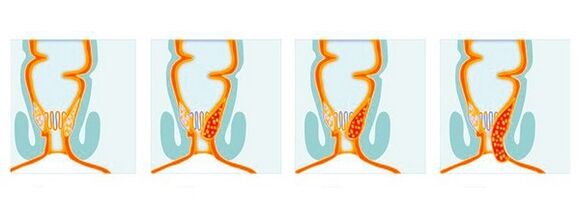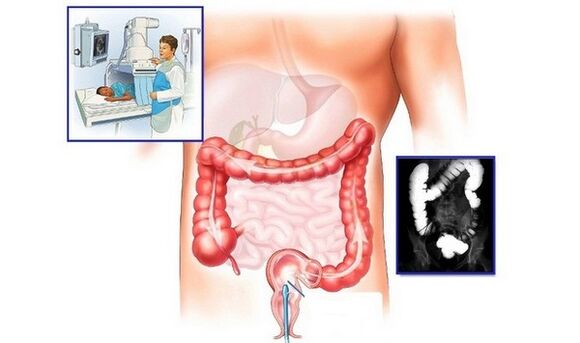
Hemorrhoids are a disease characterized by blood stasis and abnormal changes in the veins in the rectum or in the area around the anus. Such a delicate pathology has no restrictions on age and sex.
The underlying factor leading to the formation of hemorrhoidal cones is stagnation, which, in turn, results from a large number of other predisposing factors.
Pathology is characterized by characteristic symptoms that a person cannot ignore. The most specific clinical signs of hemorrhoids are itching and burning in the anal area, rectal bleeding, and severe pain in the perianal area.
The clinician will be able to make the correct diagnosis based on a physical examination, but in addition, some laboratory and instrumental tests may be required.
Treatment of hemorrhoids directly depends on the severity of the course of the disease, which is why it can be both conservative and surgical.
As the pathology has several varieties, it is coded with several meanings in the International Classification of Diseases.
Etiology
The main reason for the appearance of hemorrhoidal cones is:
- violation of the functioning of the vessels of this organ;
- increased arterial blood flow;
- disturbance of blood flow from the venous plexus;
- loss of tone of the veins of the rectum, which leads to their expansion and the appearance of nodes.
In addition, clinicians identify a large number of unfavorable factors leading to the above processes, which is why they are usually divided into several groups - pathological and physiological.
The first category of causes of hemorrhoids include:
- chronic constipation - hardened feces damages the walls of the rectum and anus;
- severe intoxication of the body - this should include poisoning with alcoholic beverages, toxic and chemical substances, as well as low-quality food;
- profuse diarrhea of an infectious nature;
- the formation of malignant, less often benign tumors in the intestine;
- diseases of the pelvic organs, such as prostatitis or cystitis;
- inflammatory diseases of the digestive system;
- hormonal disorders;
- portal hypertension and cirrhosis of the liver, as well as other conditions of this organ. The connection of hemorrhoids with the liver is due to the presence of common veins;
- the pathological influence of pathogenic bacteria that lead to the development of infections.
In addition to diseases and disorders, the causes of hemorrhoids may not be at all associated with the presence of one or another disease in the body. Among the physiological factors, it is worth highlighting:
- lack of physical activity - this occurs against the background of a wide variety of sources - laziness, a serious illness that deprives the patient of the ability to move, as well as specific working conditions in which a person is forcedto sit or stand most of the working time;
- excess body weight;
- poor nutrition - this includes the abuse of fatty and spicy foods, smoked meats, confectionery, carbonated drinks, semi-finished products, fast food and other harmful ingredients. It is for this reason that diet is one of the components of the treatment of hemorrhoids;
- indiscriminate use of drugs, including laxatives or oral contraceptives;
- incorrect performance of proctological diagnostic procedures or enemas;
- unconventional sexual preferences, namely anal sex;
- prolonged influence of stressful situations;
- perform strenuous physical activity;
- practice certain sports, in particular cycling or motorcycling, equestrian sports and other types of weight lifting;
- excessive alcohol consumption and smoking;
- maternity or work period;
- menstruation.
Genetic predisposition plays an important role in the development of the disease. Diagnosing a similar pathology in one of the closest relatives significantly increases the likelihood of lumps. Knowing this, you can independently prevent the onset of a disease, you just need to follow all the rules for the prevention of hemorrhoids.
Classification
By its clinical nature, the disease is:
- acute - this is the first manifestation of hemorrhoids that has not been diagnosed before;
- chronic - characterized by an alternation of phases of exacerbation of symptoms and their withdrawal.
Depending on the area of hemorrhoid formation, cavernous pathology is divided into:
- External hemorrhoids - this is the case if the lump appears under the skin of the anus, and not under the mucous membrane of the rectum. It is considered to be the rarest form of the disease;
- internal hemorrhoids are the most common type of pathology in which there is the appearance of vascular cones directly in the anal canal;
- Mixed hemorrhoids - the second most common type of disease, characterized by the presence of signs of the two forms described above.
In addition, there are types of hemorrhoids, divided by severity:
- mild course - symptoms may be completely absent or be expressed to an insignificant degree. Conservative methods prevail in therapy;
- medium-heavy - differs in the addition of painful sensations, which are caused by an increase in the nodes and their injury with the stool. The internal bumps fall off during the act of defecation, after which they adjust. It is possible to eliminate the disease with minimally invasive methods;
- severe - characterized by the expression of a sign of hemorrhoids such as bleeding. The lymph nodes can fall out not only during bowel emptying, but also in any other situation that causes increased intra-abdominal pressure. In such cases, they can only be adjusted manually. Tactics for getting rid of hemorrhoids can include both minimally invasive procedures and extensive operations;
- complicated - is expressed by an increase in the symptoms of the disease, and when diagnosing often the development of complications is observed, one of which may be thrombosis. However, it should be noted that in any case of untimely treatment of hemorrhoids, the formation of consequences does not occur.

Symptoms
The first signs of hemorrhoids can be so minor that a person pays no attention. The initial clinical manifestations are considered to be:
- slight discomfort in the anus;
- not intense itching of the anal area;
- pain during bowel movements;
- swelling of the entrance to the anal canal.
As the disease progresses, the following symptoms of hemorrhoids will begin to appear:
- severe burning and itching;
- increased pain, which will appear not only during a bowel movement, but also during heavy walking or sitting for a long time;
- the appearance of blood impurities and mucus in the stool. It should be noted that pathological clots do not mix with feces, but are found above them;
- prolapse of the hemorrhoidal mass, which leads to severe pain;
- redness of the skin of the perianal area;
- rectal hemorrhages - if at first such a sign of hemorrhoids could manifest itself only in the form of blood stains on toilet paper or underwear, then with a complicated course the bleeding can reach the intensity ofNS. This is what often causes a person to seek help.
In addition to specific clinical manifestations, the above symptoms of hemorrhoids can be supplemented by an increase in body temperature, which indicates the progression of the inflammatory process.
Diagnostic
It often happens that when symptoms of an illness arise, a person does not know which doctor to contact for hemorrhoids. A proctologist or surgeon is involved in the diagnosis and treatment of hemorrhoids, but for the first consultation you can contact a therapist. It should be borne in mind that if a child has any signs, it should be immediately shown to a pediatrician, and if it is a pregnant woman, he should first consult an obstetrician-gynecologist.
The first stage of diagnosis includes the work of the clinician, which aims to:
- a detailed survey of the patient for the first time signs of hemorrhoids appear - to identify the stage of the course of the disease;
- familiarization with the medical history and life history not only of the patient, but also of his relatives - this is often enough to determine the sources of the appearance of hemorrhoids;
- perform an objective examination to assess the condition of the perianal region, as well as a digital examination of the rectum, which will distinguish internal and external hemorrhoids and determine the localization of the mass.
The second step in establishing the correct diagnosis consists of laboratory examinations, namely a general biochemical blood test and a coagulogram.
The last part of the diagnosis consists of instrumental examinations of the patient, which are aimed at assessing what hemorrhoids look like and which provide for:
- sigmoidoscopy;
- anoscopy;
- colonoscopy;
- x-ray using a contrast agent;
- Ultrasound of abdominal organs.

It is only after studying the results of the examination that the clinician develops a tactic on how to cure hemorrhoids in a patient.
Treatment
The treatment regimen for the disease will depend on the severity of the disease, but common methods of treating hemorrhoids include:
- the use of drugs for local and general effects. In the first case, rectal suppositories, ointments, creams and gels are used, and in the second - tablets to improve blood circulation, strengthen the veins and neutralize the accompanying symptoms;
- membership in a savings plan - indicated for external and internal hemorrhoids. All recommendations regarding the menu and cooking methods are provided by the attending physician;
- minimally invasive techniques to remove hemorrhoids;
- open surgery;
- the use of alternative medicine recipes. This should include the preparation of candles and ointments from natural ingredients at home, as well as decoctions of herbs and medicinal plants, which are used for ingestion or as microclysters and sitz baths.
Among the minimally invasive methods of treating hemorrhoids, it is worth highlighting:
- the introduction of sclerosing substances directly into the node;
- ligation with latex rings;
- infrared and electrocoagulation;
- cryodestruction;
- desarterization.
The tactics of removing hemorrhoids will be determined by the stage of the pathology.
With the ineffectiveness of conservative methods, as well as with a complicated course of the disease, open surgical operation is indicated - hemorrhoidectomy.
How to treat hemorrhoids in pregnant women and children will be instructed by an obstetrician-gynecologist and a pediatrician.
Possible complications
Ignoring the pronounced clinical phenomena and late treatment of hemorrhoids often leads to the development of the following consequences:
- adhesion of secondary infection;
- the spread of the inflammatory process;
- insufficiency of the anal sphincter;
- profuse bleeding leading to anemia;
- proctitis and paraproctitis;
- the formation of blood clots;
- anal fissures.
Prevention and prognosis
To prevent the appearance of hemorrhoids, the following prevention rules must be observed:
- lead a healthy, moderately active lifestyle;
- eat correctly and in a balanced way;
- strengthen the pelvic and abdominal muscles;
- only take medication as directed by your doctor;
- if possible, avoid physical and emotional stress;
- timely treat constipation and other pathological causes of hemorrhoids;
- make sure the body weight is within normal limits;
- regularly undergo a complete physical examination.
It is impossible to unequivocally answer the question of the prognosis of hemorrhoids, since the result depends on several factors - the stage and form of the course of the disease, the age category, the time of initiation of treatment ofhemorrhoids and patient compliance with all clinician recommendations.
Often times, people who have been diagnosed with hemorrhoids ask if they can go away on their own. The response of doctors will always be negative - the disease will turn into a chronic form.
























